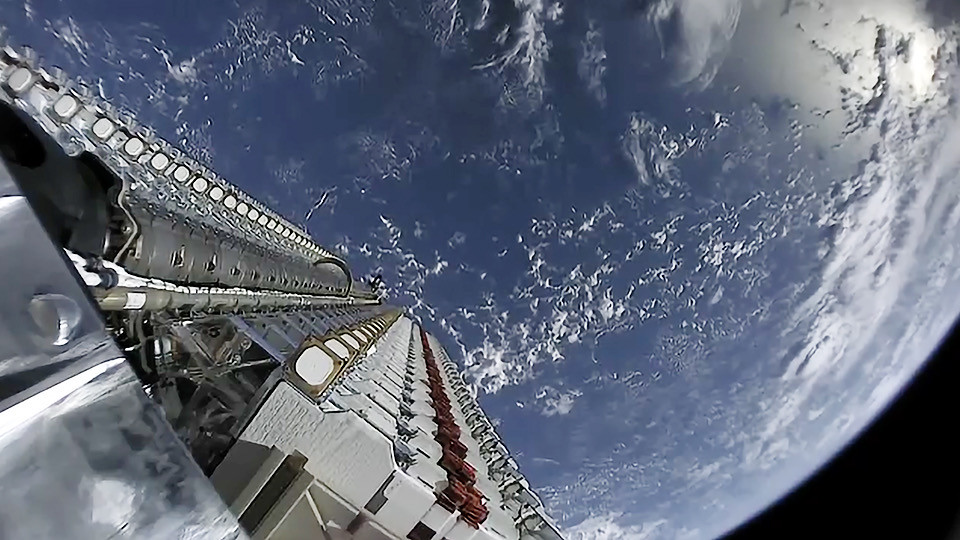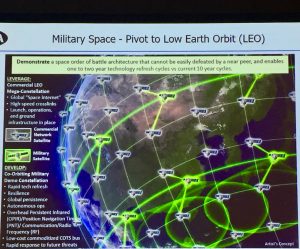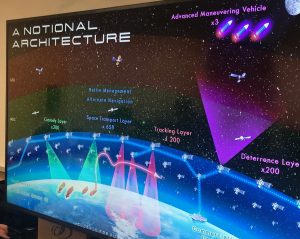
SpaceX Starlink mission
WASHINGTON: The Air Force’s Global Lightning program is readying two new contract awards to commercial satellite firms to experiment with how space-based Internet services might enhance the service’s Multi-Domain Operations (MDO).
Greg Spanjers, chief scientist of the Air Force Strategic Development Planning and Experimentation office at Wright-Patterson AFB in Ohio, told Breaking D yesterday that the two contracts could be announced as early as today. He did not, however, reveal the name of the awardees. The awards will bring the number of vendors involved to six, as the service expands the program to include not just satellite operators but also terminal and software developers.
Global Lightning is the nickname for Air Force Research Laboratory’s (AFRL) Defense Experimentation Using the Commercial Space Internet (DEUCSI) program. And it is one of the central pillars of Air Force acquisition czar Will Roper’s efforts at “digital transformation” and Chief of Staff Gen. David Goldfein’s ambitions for Multi-Domain Operations..
Enabling MDO will require moving vast quantities of data between sensors on the ground, in the air, at sea, in space and in cyberspace — the five domains of warfare — all around the globe to shooters, which in the Air Force’s case, means aircraft, drones, missiles and perhaps computers loaded with malware bullets. Thus, harnessing space-based Internet capabilities could be a killer app for MDO success.
“We’ve got a very fulsome program called Global Lightning bringing commercial comm into existing platforms,” Roper told reporters last Tuesday following a presentation at the Center for a New American Security (CNAS. “It’s desperately needed.”

Will Roper
The program, Roper explained, is intimately tied to the development of the Advanced Battle Management System (ABMS). ABMS is seen by the Air Force as the engine not just to the service’s MDO command and control network, but also for the four services’ MDO plans, known as Joint All-Domain Command and Control (JADC2) intended to link all DoD sensors to all service shooters.
Under Global Lightning, AFRL has begun a series of experiments to fit service aircraft with terminals to link to commercial space-based Internet satellites and ground stations. Those experiments started in December 2018 with connecting two demonstration versions of SpaceX’s Starlink satellites to a C-12J transport plane.
Right now, Spanjers said, AFRL is using the Starlink constellation of 60 satellites launched to Low Earth Orbit (LEO) in May and “testing with an AC-130 from Air Force Special Operations Command (AFSOC).” (SpaceX launched another 60 sats in November but they are not yet ready for prime time; it has ambitions to launch up to 30,000 satellites.) That experiment, he said, started on Nov. 15 and will be finished on Dec. 17. The next step, he said, will be a test done in tandem with the Air Mobility Command (AMC) connecting the available Starlink satellites to a KC-135 tanker that will start in Spring 2020.
SpaceX is the biggest winner so far in the the Global Lightning effort, with a $28 million award. Iridium, with 66 voice and data satellites in LEO as well as a new CloudConnect service to link products to the Internet of Things (IoT), also has a contract worth $2.5 million.
But, Spanjers explained that satellite builders are not the only commercial firms involved in the program. Ball Aerospace has been contracted for testing of ground mobile antennas, he said, via a partnership with the Army. Lockheed Martin also has been contracted for an airborne terminal, he added, “with the ability to dynamically shift between different SATCOM vendors and options.”
According to GovTribe, the Lockheed Martin contract, worth $3.6 million, was awarded Sept. 30; the Ball contract, worth $2.3 million, on Sept. 26.
“We continue to solicit new proposals and contracts through the open solicitation,” Spanjers noted.
Roper explained the Air Force’s various efforts to explore distributed LEO satellite architectures for communications and Internet connectivity are trying to “flight follow” commercial industry, that as of yet has not sorted out for itself a business case for itself.
“We think in the Air Force that the right way to go is to let commercial industry — that’s highly incentivized, with large amounts of capital, we’ve been told — to solve that distribution problem for comms first,” he said. The first question the service has to answer is “what can we do with those commercial satellites? Should we be buying them and putting them up ourselves? Should we be leasing bandwidth by paying the company that wins the race to put more up for us?”
Roper noted that he is “very deep” into the work DARPA is doing with its Blackjack effort to develop an architecture for LEO-based satellites capable of on-board data processing; as well as that of the Air Force Space and Missile System Center effort called CASINO (Commercially Augmented Space Inter Networked Operations) to figure out how to transition Blackjack’s successes to the Air Force. Part of Blackjack’s goal is to leverage the Internet in Space.

Blackjack notional architecture. Credit: DARPA
However, Roper said he has not received any briefings from the Space Development Agency (SDA) on their plans for an overarching DoD space architecture that is heavily weighted towards LEO constellations.
“I’ve never gotten a briefing from the Space Development Agency,” Roper said, “so I don’t know their plan; I don’t know what they’re intending.”
According to SDA’s new director Derek Tournear, SDA’s top priority is developing and orbiting by 2025 some 250 data “transport” satellites to link other DoD satellites to each other and the ground. Tournear told reporters at the Air Force Association’s 2019 annual meeting in mid-September that SDA intends to demonstrate the new satellites in 2021, and launch the first 20 in 2022.
The data transport satellites are only one part of SDA’s nascent National Defense Space Architecture, largely developed by SDA’s first director Fred Kennedy, that comprises seven “layers” of satellite constellations and ground station support. According to SDA’s July request for proposal, the Space Transport Layer will be a “Global, persistent, low-latency data and communications proliferated ‘mesh’ network to provide 24×7 global communications.”
If you think this sounds an awfully lot like what Blackjack intends to do, and what Global Lightning is doing, you’d be thinking right. Indeed, Tournear — and his boss Mike Griffin, DoD chief of Research & Engineering — has repeatedly stressed that SDA is coordinating closely with DARPA and SMC, including on potential transition of Blackjack technologies to SDA’s architecture.
But given that SDA has put together an $11 billion, five-year budget plan starting in fiscal 2021, the fact that the Air Force’s top acquisition official says he has not been briefed seems to us, at a minimum, odd.

Space Development Agency notional space architecture
Roper, for his part, wouldn’t be drawn by reporters on whether he was concerned about the lack of contact with SDA, noting that he believes “SMC has done meetings with them.”
He added, however, “If their budget closes and they’re going to go out and plan, I would hope that we would work together on it, because we’re going to have to bring whatever they do into space and have common ideas on things like comm, and cloud and data.”






















